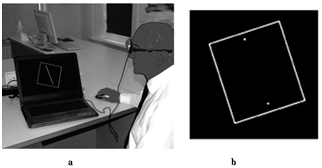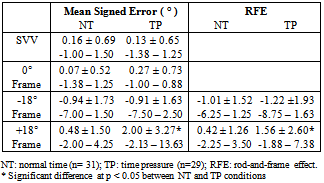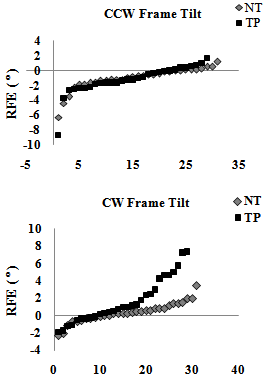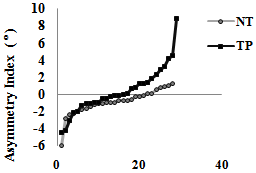-
Paper Information
- Previous Paper
- Paper Submission
-
Journal Information
- About This Journal
- Editorial Board
- Current Issue
- Archive
- Author Guidelines
- Contact Us
International Journal of Brain and Cognitive Sciences
p-ISSN: 2163-1840 e-ISSN: 2163-1867
2013; 2(3): 45-50
doi:10.5923/j.ijbcs.20130203.02
Asymmetric Rod and Frame Effect on the Computerized Rod and Frame Test under Time Pressure
Rima Abdul Razzak
Dept. of Physiology, Arabian Gulf University, Complex 329, Salmaniyah Road, Manama, Bahrain
Correspondence to: Rima Abdul Razzak, Dept. of Physiology, Arabian Gulf University, Complex 329, Salmaniyah Road, Manama, Bahrain.
| Email: |  |
Copyright © 2012 Scientific & Academic Publishing. All Rights Reserved.
This study tested the effects of perceived time pressure on subjective visual vertical (SVV) perception in college healthy male students. Delayed down-weighting of inaccurate visual cues has been implicated in age-induced overreliance on visual information, which may be disruptive for postural control. Accordingly, I hypothesized that under time pressure, participants may not have enough time to downgrade the distracting visual input from the tilted frame and display larger rod-and-frame effects (RFE) on a computerized rod and frame test (CRAF), with a virtual line of two endpoints and a precision of 0.5°. All participants were right handed, with 31 in the normal time (NT) and 29 in the time pressure (TP) experimental conditions. Results showed that the feeling of acting under time pressure induced rightward SVV adjustments (counter clockwise (CCW) SVV estimates) in the nontilted frame context and an increased rod and frame effect (RFE), but only significantly with a right tilt of the frame. This indicates an increased tendency for CCW SVV estimates and marked asymmetries in the magnitude of the frame effects for left and right frame tilt under time pressure. In view of these findings I believe that quick actions may provoke abnormal weighting of cues mediating verticality perception due to an asymmetrical processing of visual information leading to an inefficient integration of sensory information in brain areas involved in SVV representation under time pressure. These findings may prove significant at a postural level for visually dependent individuals who may need to carry out postural orientation corrections quickly within environments rich with obliquely oriented visual cues.
Keywords: Time Pressure, Subjective Visual Vertical (SVV) Perception, Visual Dependence, Computerized Rod and Frame Test
Cite this paper: Rima Abdul Razzak, Asymmetric Rod and Frame Effect on the Computerized Rod and Frame Test under Time Pressure, International Journal of Brain and Cognitive Sciences, Vol. 2 No. 3, 2013, pp. 45-50. doi: 10.5923/j.ijbcs.20130203.02.
Article Outline
1. Introduction
- Spatial orientation requires knowledge about the direction of gravity, which is essential for maintaining upright body posture and for judging visual orientations in space. A fundamental spatial reference for spatial orientation and maintaining an erect bipedal posture stance and balance on Earth[23, 2] is subjective visual vertical (SVV). The central representation of this SVV is based on the integration of vestibular, visual and somatosensory cues. Perceptual preferences for spatial orientation vary within the normal population with some individuals relying more on vision (allocentric frame of reference), hence categorized visual field dependent (FD) and others on vestibular-proprioceptive cues and are known as visual field independent (FI)[16]. However, some individuals are at the center of the field dependent/independent continuum compared to those at the two extremes[20]. Some factors that affect reliance to visual cues include old age[18,19], and vestibular dysfunction.The concept of field dependence is important, because the degree of visual field dependence indicates the degree to which an individual relies on visual information for postural corrections[10]. Assessment of perceptual visualdependence- independence is a practical means of predicting a subject’s preferences to stabilize and orient his body relative to visual or non-visual frame of reference[11]. Another important process when people attempt to balance is sensory weighting and selection between sensory inputs, the selection of which is based on the usefulness of the sensory input to balance. Accordingly, the weight on a reference frame (modality) may need to be modified[24], because of changing environmental conditions, with this sensory reweighting process being critical for perceptuomotor control[3] and maintaining postural stability in a dynamic environment[6]. In particular, since it accurately represents the orientation of the environment, a stationary full field visual stimulus provides a useful reference therefore its associated weight will increase to improve postural stability[13, 15]. However, when static visual frames of reference are tilted, they can induce postural tilt or sway in standing observers, because such visual cues conflict with other egocentric cues to spatial orientation[11], therefore, the weight assigned to the visual channel needs to be reduced in order to preserve balance. The time to reweight sensory cues, specifically visual cues has also been shown to affect balance integrity. Studies in older adults have suggested that they require more time for reweighting sensory information required for maintaining balance, and this potentially leads to increased incidence of falling in rapidly changing or cognitively demanding environments[7]. Specifically, it is the delayeddown-weighting of inaccurate visual cues that has been implicated in age-induced overreliance on visual information, which may be disruptive for postural control[10, 6]. Accordingly, the aim of this preliminary study was to identify the directionality (facilitative or debilitative) of time pressure on reliance to visual cues that modulate SVV perception. SVV perception is usually tested by the rod-and-frame test (RFT)[28] where the rod is aligned to vertical within a frame to determine the effect of visual cues on SVV. The tilted frame surrounding serves as a distracter or inaccurate visual cue for SVV perception, and in healthy individuals under normal conditions of testing, a rod and frame effect (RFE), or systemic deviations are evoked in the direction of the tilted frame in tilted frame presentations[5, 17]. The current hypothesis is that time restriction/pressure may not allow participants enough time to down weight the distracting visual cues of the tilted frame. Accordingly, we expect higher reliance on visual cues and larger SVV deviation errors in subjects performing under time pressure than under normal time conditions. SVV was tested in young healthy male college students on a computer adaptation of the classical RFT. A virtual line (two endpoints) represented the rod in order to reduce clues to verticality which can be provided by the stepped appearance of a solid line when displayed on the computer screen[4].
2. Methods
2.1. Participants and Experimental Design
- 62 right-handed young male college students (age: 19.72 ± 1.13 years) volunteered for this study and were divided into two groups according to different task processing instructions, specifically time limitation, but two withdrew. Under the normal time (NT) condition, 31 participants were instructed to take as much time as they needed to align the rod to vertical and that accuracy of alignment was critical. The time pressure (TP) condition was created by asking 29 participants to adjust the rod to vertical as quickly and accurately as possible with emphasis that response time was critical for their score and that their time for each frame presentation was limited to 7s. This presentation time was calculated as the mean of the mean response times in the four frame presentations for the group under no time pressure.
2.2. The Computerized Rod and Frame (CRAF) Test
- The Computerized Rod and Frame (CRAF) test we used is a modified version of the program described by Bagust[1]. Subjects were tested in the upright position and they viewed the computer screen using head mounted video eye glasses (VUSIX iWEAR, VR920 Video Eyewear, Figure 1a), which restricted the field of vision and gave the impression of viewing a large screen from a distance of 2m (Figure 1b). The subject was presented with a square white frame on a plain black background. Within the frame, the ends of a virtual line were marked by two white dots (which could be rotated around its center in either clockwise or anticlockwise directions using the mouse buttons. The starting position of the rod was ±20° away from the vertical, and it could be moved in 0.5° increments.
2.3. Statistical Analysis
- Data was analyzed using the GraphPad InStat3 software. All data passed normality by the Kolmogorov and Smirnov test. The normal time (NT) condition and the time pressure (TP) condition were compared for the SVV estimates using the unpaired t-test. Welch’s correction applied was used when assuming that the two populations of data have different standard deviations (SDs). For all tests, the significance level was fixed at 0.05.
3. Results
- The instruction to respond as quickly and accurately as possible led to a significant reduction in the mean response time across all frame presentations. Participants in the TP condition only required 60-70% of the alignment time utilized in the NT condition. The response time data was not further analyzed as the purpose of the time restriction was only to introduce a feeling of time pressure. In both time conditions, SVV adjustments without a frame were very accurate and in both directions with a mean positive constant error. There was no effect of time pressure on SVV judgments, as the signed error in the TP group was almost identical to the error in the NT group (t (58) = 0.18, p = 0.86) (Table 1). For SVV in the vertical frame context, the mean signed error in the TP group was modestly greater than in the NT group, however the results were not statistically significant (Welch’s t (50) = 1.24, p = 0.22). Interestingly, a one sample t-test on the constant errors showed that in the NT condition, the error was positive but not different from 0 (t (30) = 0.70, p = 0.49), while in the TP condition, the error was also positive and almost significantly different from 0 (t (28) = 1.97, p = 0.058).
|
4. Discussion
- The present results demonstrate mild spatial alterations in judgment of verticality in healthy subjects acting under pressure and provide a possibility that time pressure may affect the interactions of visual inputs with vestibular and somatosensory inputs involved in verticality perception. The effects that time pressure may have on SVV adjustments were investigated with a virtual rod on the CRAF. When aligning the rod to vertical without a surrounding frame, subjects acting quickly did not have different magnitudes in errors or bias in SVV estimates from subjects with no time limitation. This indicates that subjects under time pressure have no difficulties in estimating SVV when no visual cues are present. Since SVV without additional visual cues of orientation relies mainly on gravitational (vestibular) input, and SVV tilts are a sensitive sign of vestibular dysfunction or imbalance[27], this implies that the graviceptive vestibular tone balance was not affected by processing time restriction. This is practical as under most circumstances, humans use gravity as a global, external reference for spatial orientation relying on the brain’s ability to continuously update an internal model of this gravitational referential within each moment of time[2, 18].With the presence of a visual frame, observers perceive rod orientation with reference to frame orientation and to gravity, so that the resulting rod adjustment usually is a compromise between the two references[8]. When symmetrical visual cues were introduced by insertion of the vertical frame around the rod, there was no significant difference in SVV constant errors between the two time conditions. However the one-sample t-test showed that only in the TP condition was the constant error almost significantly different from 0 and biased to the right. This would indicate that most participants had a positive constant error resulting from CCW tilt of their SVV estimates under time pressure. Since graviceptive input was shown to be balanced in these subjects, this indicates that the CCW SVV tilt may have either resulted from asymmetric flow of visual input or from asymmetrical weighting of the visual input in brain areas related to multisensory integration and space representation in the right temporo-parietal cortex[26]. A tilted frame, at the perceptual level, can produce an illusion of self-tilt in the direction opposite to that of the frame, and for compensation the rod is aligned in the direction opposite to that of the felt body tilt, therefore into the direction of frame tilt[9]. The increase in RFE indicates a greater degree of visual field dependence under time pressure, which in turn indicates the degree to which an individual relies on visual information for postural corrections[10].My theory was that with time pressure, subjects would not have enough time to down weight the distracting visual input from the tilted frame, and consequently would display greater rod-and-frame effects (RFE) for both directions of frame tilt. Comparing between the two time conditions, the results indicate that SVV judgments within the right oriented frame were significantly larger when subjects were acting quickly than subjects in normal time; the greater SVV to the right under time pressure indicate a greater CCW SVV estimate with an over-compensation to the right in rod adjustment., however this effect was not evident in the leftward tilted frame as the frame effects were not significantly different between both time conditions. This signifies marked asymmetries in the magnitude of the frame effects for left and right frame tilt under time pressure, with subjects having substantial orientation bias towards the right when acting quickly. This was also revealed in the non-significantly more positive mean asymmetry index under time pressure than under normal time conditions in which there was negative mean asymmetry index. Accordingly, one may be tempted to deduce that there exists a general tendency towards a more CCW tilt (right alignment) of SVV in any visual frame context under time pressure. One may also argue that the RFE in the leftward frame could have been more negative under time pressure, were it not for the almost significantly right biased SVV constant error in the nontilted frame context. Motor factors could also be implicated, but they are unlikely to have contributed to the observed asymmetry in SVV and rod and frame effect (RFE) under time pressure. Even if all the participants were right-handed, motor manipulations of the computer mouse were minimal, as the mouse remained in a fixed position, with the rod being rotated to the right or left by a simple mouse right or left-click. Therefore, over-alignment of the SVV to the right could not have stemmed from an increase in motor adjustment resultant from right-handed users’ natural right bias when moving the right hand, but it is most likely perceptual in origin.These findings are reminiscent of results with left spatial neglect patients who generally displayed a systematic CCW tilt (right alignment) in their SVV judgments[8], but with greater magnitudes of SVV deviations. Other studies with neglect patients have shown that the directions of the tilts were shown to depend on the lesion location, as patients with left hemispheric lesions showed clockwise tilts in the SVV in roll[14]. In neglect patients, the processing of gravitational input was impaired (asymmetric), and the counter clockwise tilts were most likely associated with right-parieto-temporal lesions[26]. In our healthy subjects, SVV adjustments without a frame showed no directional biases under any time condition, indicating intact gravitational information. Such information is integrated with that about the orientation of the frame and can be used as an “intrinsic” reference for vertical perception to the same extent under both time conditions. Thus the abnormal weighting of cues mediating space/verticality perception might be the consequence of a reduced integration of sensory information in the parietal cortex due to an asymmetrical processing of visual information with time pressure. This may result from the fact that visual input from the right hemifield projecting to the left visual cortex requires more time to reach the right brain areas involved in SVV representation than visual input from the left hemifield projecting directly to the right side of the brain.
5. Conclusions
- The current results suggest that time pressure can modulate sensory processing and weighting of visual inputs contributing to judgment of verticality in healthy subjects. It is worth noting that the constant errors and frame effects reported here are still within the normal range, however, they may be exaggerated in field-dependent individuals and in the elderly.At the postural level, a visual frame of reference lean may optically evoke a fall (acceleration) of the body in the opposite direction of the frame tilt. Hence, anti-falling postural adjustments are automatically generated resulting in postural orientation corrections in the opposite direction to the perceived body tilt[11]. However, some quick actions under time pressure may be unpredictable balance threatening events, which usually lead to an increase in the anchoring to vision for controlling balance[23, 12]. Under time pressure visually dependent individuals may comfortably rely on visual references they know as being stable and indicative of verticality like the edge of walls, doors, windows, however in an environment rich with obliquely oriented cues, they may have more difficulty relying on such references.Finally, this study indicates the presence of a relationship between time pressure and a tilted, less precise perception of visual vertical. However, a limitation of this study is that the present results do not necessarily imply a direct causal link between time pressure and the spatial orientation difficulties reported in this study.
ACKNOWLEDGEMENTS
- I would like to acknowledge Prof. Jeffery Bagust at the Anglo-European College of Chiropractic (AECC) in Bournemouth, England for providing the Computerized Rod and Frame Test (CRAF) software and Sharon Docherty at the AECC for her support.
 Abstract
Abstract Reference
Reference Full-Text PDF
Full-Text PDF Full-text HTML
Full-text HTML


